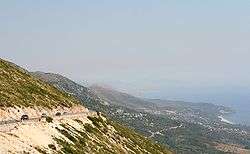Himara
| Himarë | ||
|---|---|---|
| Municipality | ||
|
The region of Himara seen from the Ceraunian Mountains | ||
| ||
 Himarë | ||
| Coordinates: 40°7′N 19°44′E / 40.117°N 19.733°ECoordinates: 40°7′N 19°44′E / 40.117°N 19.733°E | ||
| Country |
| |
| County | Vlorë | |
| Government | ||
| • Mayor | Jorgo Goro (SP) | |
| Area | ||
| • Municipality | 571.94 km2 (220.83 sq mi) | |
| Population (2011) | ||
| • Municipality | 5,738 | |
| • Municipality density | 10/km2 (26/sq mi) | |
| • Administrative Unit | 2,822 | |
| Time zone | CET (UTC+1) | |
| • Summer (DST) | CEST (UTC+2) | |
| Postal Code | 9425 | |
| Area Code | (0)393 | |
| Vehicle registration | AL | |
| Website | Official Website | |
Himara or Himarë (from Greek: Χειμάρρα, Himarra, definite Albanian form: Himara) is a bilingual[1] region and municipality in southern Albania, part of Vlorë County. It lies between the Ceraunian Mountains and the Ionian Sea and is part of the Albanian Riviera. The region consists of the town of Himarë and the villages of Dhërmi, Pilur, Kudhës, Qeparo, Vuno, Ilias,[2] and Palasë.
The region of Himara is predominantly populated by an ethnic Greek community.[3][4][5][6]
Geography
The Himara region is a strip approximately 20 km long by 5 km wide, bounded by the 2000 metre high Llogara mountains to the northeast (known in antiquity and in the local Greek dialect as the Ceraunian mountains (Greek: Κεραύνια Όρη, Keravnia ori, "Thunder Mountains") and the Ionian Sea to the southwest. There are long white sandy beaches and the few hills close to the sea are terraced and planted with olive and citrus trees.[7] The villages of Himarë are perched up high on the spurs of the Ceraunian range in positions which offered natural defences against the nearby Lab Albanians during the Ottoman era.[4]
Attractions
The area has a great potential for tourism, with the major characteristics of the municipal town being its seaside promenade, the Greek tavernas and the traditionally preserved old town built on a hill.[8] The town of Himarë consists of the old town, Kastro, situated on and around the old castle and the coastal region of Spilea, which is the touristic and economic center of the region. Other parts of the town are Potami, Livadhi, Zhamari, Michaili and Stefaneli. North of the town of Himarë lie the villages of Vuno, Ilias, Dhërmi, with its coastal region Jaliskari, and Palasë. Dhermi contains a number of recently built beach resorts. On the mountains lie Pilur and Kudhës, while Qeparo lies to the south of the town of Himarë.[7]
The region has several Orthodox churches and monasteries, built in the traditional Byzantine architecture, like the Monastery of the Cross, Athaliotissa, Saint Theodore, Virgin Mary in Dhërmi and Saint Demetrius. Moreover, a number of churches are located inside the castle of Himarë, which was initially built in classical antiquity, like the Church of Virgin Mary Kasopitra, Episkopi, which is built on the site of an ancient temple dedicated to Apollo, as well as the Aghioi Pantes church, in the entrance of the castle. Additional monuments in the castle include the mansion of the Spyromilios family and the Greek school.[7]
History
Antiquity
.svg.png)
In antiquity the region was inhabited by the Greek tribe of the Chaonians.[9] The Chaonians were one of the three principal Greek-speaking tribes of Epirus, along with the Thesprotians and the Molossians.[10][11] The town of Himarë is believed to have been founded as Chimaira[12] (Χίμαιρα[13]) by the Chaonians as a trading outpost on the Chaonian shore. However, another theory suggest that it comes from Greek χείμαρρος (cheimarros), meaning "torrent".[14]
In classical antiquity, Himarë was part of the Kingdom Epirus under the rule of the Molossian Aeacid dynasty, which included King Pyrrhus of Epirus. When the region was conquered by the Roman Republic in the 2nd century BC, its settlements were badly damaged and some were destroyed by the Roman General Aemilius Paulus.
Middle Ages
Himara and the rest of the southern Balkans passed into the hands of the Byzantine Empire[15] following the fall of Rome, but like the rest of the region it became the frequent target of various attackers including the Goths, Avars, Slavs, Bulgars, Saracens and Normans. Himara is mentioned in Procopius of Caesarea's Buildings (544)[16] as Chimaeriae, being part of Old Epirus and that a new fortress was built in its location. In 614, the Slavic tribe of the Baiounetai invaded the area and controlled a region from Himarë to Margariti called "Vagenetia".[16]
The use of the name "Chaonia" in reference to the region apparently died out during the 12th century, the last time it is recorded (in a Byzantine tax collection document). In 1278, Nicephorus of Epirus surrendered to the Angevins the ports of Himarë, Sopot and Butrint. As a result, Charles of Anjou controlled the Ionian coast from Himarë to Butrint.[17] It was later ruled by Serbian Empire between 1342 and 1372. In 1372 Himarë, together with Vlora, Kanina and Berat region was given as a dowry to Balša II due to his marriage with the daughter of John Komnenos Asen. After the death of Balša II, his widow and his daughter (who married Mrkša Žarković) managed to keep the possession of the region up to 1417 when the Ottomans captured Vlora.[18]
Ottoman era: autonomy and revolts
The Ottoman Empire overran northern Epirus from the late 14th century, but being a natural fortress, Himara was the only region that did not submit to Ottoman rule. It became a symbol of resistance to the Ottoman but suffered from an almost continuous state of warfare. In the summer of 1473 the chieftain John Vlasis, with a small unit from nearby Corfu as well as with native Himariot support, took control of the entire coastal region from Sagiada to Himara, but when the ongoing Ottoman-Venetian war ended (1479) the region was again under Ottoman control.[19] In 1481, one year after the Ottomans had landed in Otranto in southern Italy, the Himariotes joined the forces of Gjon Kastrioti II (son of Skanderbeg) in his uprising against the Ottomans.[20] The uprising failed, but the Himariotes rose up again in 1488, and between 1494–1509, destabilizing Ottoman control but failing to liberate their territory.
The Ottoman Sultan Suleiman the Magnificent personally mounted an expedition in 1537 that destroyed or captured many surrounding villages but did not manage to subdue the area. The Ottomans found it necessary to compromise with the inhabitants by giving them a series of privileges: local self-government, the right to bear arms, exemption from taxes, the right to sail under their own flag into any Ottoman port and to provide military service in time of war.[21] However, despite the privileges, the Himariotes revolted during the following conflicts: Ottoman–Venetian War (1537–40), Ottoman–Venetian War (1570–73), Morean War (1684–99), Ottoman–Venetian War (1714–18) and the Russo-Turkish wars of the 18th century. On the other hand, Ottoman reprisals depopulated the area and led to forced Islamizations which finally limited the area's Christian population by the 18th century to the town of Himarë and six villages.[22] Additionally the Himariotes were often attacked by the Labs, a nearby Albanian tribe, on the grounds of race and religion.[23] In one occasion, in 1577, the chieftains of Himarë appealed to the Pope for arms and supplies promising to fight the Ottomans. They also promised to transfer their religious allegiance to Rome, provided that they will retain their Eastern Orthodox liturgical customs since the majority of the population was Greek and didn't understand the Frankish language.[24]
During these years, the people of Himarë established close links to the Italian city states, especially Naples and the powerful Republic of Venice, which controlled Corfu and the other Ionian Islands, and later with Austro-Hungary. It was at this time (18th century), that many Himariotes emigrated to Italy, while they still maintain their Greek identity.[25]
The first school in the region opened in 1627, where lessons were held in the Greek language. The following years (until 1633) Greek-language schools opened also in the villages of Dhërmi and Palasa.[26] During the Ottoman period, judicial authority in Himarë and the surrounding villages was exercised by community courts also known as "councils of elders", that consisted exclusively of laymen. Their decisions was subject to the sanction of the local Orthodox bishop who belonged to the metropolis of Ioannina.[27]
In 1720, the villages of Himara, Palasa, Ilias, Vuno, Pilur and Qeparo refused to submit to the Pasha of Delvina.[28] In 1759-1760 local agents of the Russian Empire reported that the population of Himarë was willing to join an anti-Ottoman uprising, provided the Russians would support a liberation movement of the Greek-inhabited regions of the Ottoman Empire.[29]
Late Ottoman period
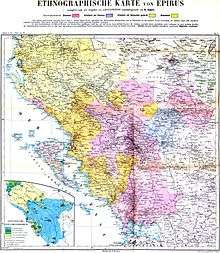
In 1797, Ali Pasha, the Muslim Albanian ruler of the Ottoman Pashalik of Yanina, led a raid on the town of Himarë because they supported his enemy, the Souliotes, and more than 6,000 civilians were slaughtered.[30] Two years later, Ali Pasha tried to create good relations with the Himariotes after declaring their enclave part of his emerging semi-independent state, by financing various public works and churches. A church he built near Himarë, opposite of the Porto Palermo (Panormos) Castle is the largest and most magnificent in the region and still stands today as a major tourist attraction. Ali Pasha's rule over Himarë lasted about 20 years until it was abruptly terminated by his murder at the hands of the Ottoman agents. Himarë subsequently reverted to its status quo ante of an enclave surrounded by Ottoman territory. To emphasize the region's special status, the terms that the Himariotes had reached with Suleiman the Magnificent were inscribed on bronze tablets at the request of their leaders, who wanted to record the agreement on a durable medium. These tablets are preserved to this day in the Topkapi palace museum in Istanbul.
When the Greek War of Independence (1821–1830) broke out, the people of Himarë rose in revolt.[31] The local uprising failed, but many Himariotes, veterans of the Russian and French Army, joined the revolutionary forces in today southern Greece, where they played a significant role in the struggle.[32] In 1854, during the Crimean War, a major local rebellion broke out, with Himarë being one of the first towns that joined it. Although the newly founded Greek state tried tacitly to support it, the rebellion was suppressed by Ottoman forces after a few months.[33][34] The Himariotes were continuously held suspicious of supporting the expansionist plans of Greece in the region, especially during the era of the Albanian national awakening.[35]
20th century
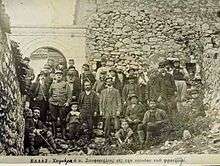
During the First Balkan War, on November 18, 1912, the town revolted under Spyros Spyromilios and expelled the Ottoman forces[36][37] in order to join Greece. In March 1914, the "Protocol of Corfu" was signed, which established the Autonomous Republic of Northern Epirus, of which Himarë formed a part, though the Autonomous Republic itself formally remained part of the newly formed Albanian state. However, in the Panepirotic assembly in Delvinë, that aimed at the ratifications of the terms of the Protocol by the Northern Epirote representatives, the delegates of Himarë abstained, insisting that only union with Greece would be a viable solution.[38]

During the First World War, Himarë was under Greek administration (October 1914-September 1916) and then occupied by Italy. The Italians used Austro-Hungarian prisoners of war to build a road running through Himarë, which greatly reduced the region's isolation. Spiro Jorgo Koleka, a native of Vuno and a local leader of the Albanian national movement, opposed the annexation by foreign powers of Himara area and the wider region around Vlora .[39] To that effect Koleka was an organiser of the Vlora War, where other local Himariots participated.[39] In 1921 the region came under the control of the Albanian state. The Himara question in 1921, regarding the rights of "Himariotes" and their villages Dhërmi, Vuno, Himara, Piluri, Kudhës and Qeparo, was supervised by Albanian government representative Spiro Jorgo Koleka.[40] The government concluded that Albanian was obligatory in school, as the official language, while Greek was free to be taught as a second language, as desired by the people.[40] The locals rose in revolt, in 1924, protesting against a series of measures aiming at Albanisation, and demanding the same privileges they enjoyed prior to incorporation to Albania.[41] Other uprisings followed in 1927 and 1932, both suppressed by the government of king Zog of Albania.[42]
Later, Himarë was again occupied by the Italians as part of the Italian invasion in Albania. During the Greco-Italian War, the 3rd Infantry Division of the Greek Army entered Himarë, in December 22, 1940, after victorious fighting against the Fascist Italian forces deployed in the region. The town briefly re-joined Greece until the German invasion in 1941.
In 2015 the government merged Himara with the municipalities Horë-Vranisht and Lukovë. The seat of the municipality is the town Himarë.[43]
Demographics
The population of the Himarë region is 11,257 inhabitants,[44] with the ethnic composition of both the town and region predominantly Greek.[45][46] The town of Himarë and the settlements of Dhërmi and Palasë, which account for the bulk of the region's population, are inhabited by Greeks, while Pilur, Kudhës, Vuno and Ilias are populated by an Orthodox Albanian population.[47] The village of Qeparo is inhabited by both Greeks (upper neighbourhood) and an Orthodox Albanian population (lower neighbourhood).[47] On the other hand, the latest official census in Albania (2011), which has been widely disputed due to irregularities in the procedure,[48][49][50] and its results affected by boycott by part of the Greek minority,[51] shows that 60.38% were registered as Albanians, 24.56% as Greeks and 14.00% preferred not to declare any ethnicity at all.[52]
Historically, there have been several conflicting theories about the ethnicity of the Himariotes. In the early 19th century according to Greek scholar and secretary to Ali Pasha Athanasios Psalidas, three villages of the area were considered Greek, while he also stated that there were also some Orthodox Albanian villages in the region.[53] In general, the allegiances of the locals were in a narrow sense to their respective clans (the “phatriae”) and areas, and in a broader sense to their Orthodox religion and cultural heritage. The later factors indicate closer links with their Greek co-religionists than to the Muslim Albanian communities.[54]
Politics
The possibility of victory by the Greek minority Unity for Human Rights Party in the municipal elections in the past triggered nationalist rhetoric, both at the local and even national level, and heightened tension in the town.[55][56] The Unity for Human Rights Party secured the greatest number of seats in the current municipal council, during the last municipal elections, however the mayorship was won by the Socialist party, and mayor is Gjergi Goro in the town of Himara (2011).[57][58] In the last governmental elections (2013), the region of Himara voted 48.3% for the Socialist Party and 25.5% for the Unity of Human Rights party.[59]
Religion
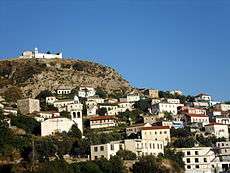
The inhabitants of Himara are predominantly Orthodox Christians.[60] In 1577, 38 chieftains of the Himara region appealed to Pope Gregory XIII for arms and supplies against the Ottomans. They promised to switch allegiance from the Orthodox to the Roman Catholic Church, and recognize Philip II of Spain as their sovereign. They asked to retain their Orthodox liturgical customs 'since the majority of the population is Greek and does not understand the Frankish language'.[61] From 1577 to 1765 the population accepted the Pope as the religious head of the community and identified with the Roman Catholic Church.[61] The success of the Roman Catholic missionaries among the Eastern-rite Albanians in Himarë led to the region becoming a refuge for Orthodox prelates that had converted.[61] Himariotes thus largely adhered to Christian faith, although individual conversions to Islam were recorded from early 16th century. One of them, Ajaz Pasha, became Grand Vizier and was sent by the Ottoman Sultan to put down the 1537 revolt of Himariotes. Even so, crypto-Christianity appeared, particularly in the villages of Fterre, Corraj, and Vuno. Moreover, Basilian missions were sent by Rome since 1682,[62] founding a number of Greek schools.[26]
In August 2015 Albanian police demolished the renovated Orthodox church of Saint Athanasius in Dhermi, as local authorities weeks earlier declared it an “illegal construction”.[63] The Orthodox Autocephalous Church of Albania declared it a vandalistic act of desecration and a violation of church property and it also triggered diplomatic protests from Greece.[63] This is the second demolition of the church, the first having taken place during the era of the People's Republic of Albania, but at the time the church was rebuilt by the local Orthodox Church after the restoration of Democracy in the country (1991).[63][64] The Albanian government has promised to rebuild the church after archaeological excavations have taken place.[63][65] The demolition of the religious monument also triggered strong reactions from the European Commission.[66]
Language
The vast majority of people in Himarë, who call themselves "Horiani" (Greek: Χωριανοί), meaning locals in the local Greek dialect,[67] are bilingual in both Albanian and Greek, while 85% of the municipality's population use Greek as their mother tongue according to the municipal authorities.[7] In the town of Himarë as well as in nearby villages of Dhërmi and Palasa mainly speak a unique local Greek dialect that preserves many archaic features no longer found in standard Modern Greek. This dialect has small variations in the way it is spoken in every town, especially in the accent. On the other hand, the surrounding towns of Ilias, Vuno, Qeparo, Kudhës and Pilur mainly speak the Tosk Albanian dialect.[68]
In the spring of 2006, a private Greek-language school opened in the town of Himarë,[69] at the precise location where the Orthodox missionary Cosmas the Aetolian founded the Acroceraunian School in 1770.[7]
Minority issues
While the situation of the Greek minority in Albania has improved since the fall of communism, ethnic tensions in Himara remain high.[70][71] During the 1994 trial of the Omonoia members, an organization that represents the Greek minority in Albania, three local Greeks were arrested and beaten by the Albanian police after they were found in possession of leaflets calling for the release of the arrested Omonoia leaders.[72] In 2008, a number of protests took place with the locals demanding land ownership and autonomy for the region.[73] The house of former mayor of Himara's, Vasil Bollano, has been the target of a bomb attack twice, in 2004 and again in May 2010.[74]
On August 12, 2010, ethnic tensions soared after ethnic Greek shopkeeper Aristotelis Goumas was killed when his motorcycle was hit by a car driven by three Albanian youths with whom Goumas allegedly had an altercation when they demanded that he must not speak Greek to them in his store.[70][71] Outraged locals blocked the main highway between Vlore and Saranda and demanded reform and increased local Himariote representation in the local police force.[71] The incident was condemned by both the Greek and Albanian governments and three suspects are currently in custody awaiting trial.[71]
The census of 2011 included ethnicity for the first time, a long-standing demand of the Greek minority in Albania and of international organizations.,[70] however, Greek minority representatives found unacceptable article 20 of the Census law, according to which there is a $1,000 fine for declaring an ethnicity other than what was written down on someone's birth certificate.[75] As a result the census was boycotted by parts of the Greek community.[76]
In 2005, after years of unanswered demands, President Berisha authorized the opening of a Greek-language school in Himara partially funded by the Greek government.[70] The school now has five teachers and 115 pupils.[70]
On 2015, 26 August, Albanian government demolished the church of St. Athanasios at Drimades. Greek Ministry of Foreign Affairs condemned this action.[77]
Sports
The city of Himarë's soccer club SK Himarë. The club currently plays in the Albanian Second Division.
Notable Himariotes
- Dhimitër Anagnosti, People's Artist of Albania, cineast, and former Minister of Culture, Youth and Sports born in Vuno.
- Christos Bekas, Greek Army general in the Greek War of Independence (1821–1830).[78]
- Panos Bitsilis, revolutionary.
- Vasil Bollano, former mayor of Himarë and President of the organization of the Greek minority, "Omonoia".
- Pyrros Dimas, the world-famous Greek weight-lifting athlete, whose nickname is "the Lion of Himarë". He is the only weight-lifter in the world to have won four Olympic medals. Three of his medals are gold (1992 Summer Olympics, 1996 Summer Olympics, 2000 Summer Olympics) and the last one, from the Athens 2004 Olympics, is a bronze.
- Christos Armandos Gezos, novelist and poet.
- Kostas Kaznezis, Greek Army general in the Greek War of Independence.[79]
- Spiro Koleka (1908–2001), long-serving member of the Politburo of the Party of Labour of Albania.
- Petro Marko, one of the most famous Albanian writers of the post World War II era.[80]
- Zachos Milios (1805–1860), Greek Army officer and revolutionary.
- Paskal Milo politician
- Neço Muko, famous Albanian musician of the 1920s and creator of the avaz himariote music genre that became identified with Himarë.
- Robert Ndrenika, actor
- Andon Qesari, actor and director
- Sotiris Ninis football player of Panathinaikos F.C. (Superleague Greece)
- Athanasios Pipis (-1821), revolutionary of the Greek War of Independence, from Vuno.
- Spyromilios (1800–1880), Greek Army general and politician.
- Spyros Spyromilios (1864–1930), Greek Gendarmerie officer, declared the region's autonomy (1914).
- Pyrros Spyromilios (1913–1961), Greek Navy officer and director of the Greek Radio Orchestra.
- Georgios Stephanou (1824-1901), Greek gendarmerie officer and leader of the Epirus Revolt of 1878.
- Andreas Tatos (1989-), football player of Olympiakos F.C. (Greek Superleague).
- Ayas Mehmed Pasha (1483–1539), grand vizier of the Ottoman Empire from 1536 to 1539.
- Odhise Grillo, (1932-2003), writer of children's books.
Gallery
-

The Ionian sea at sunset seen from the Llogara pass.
-
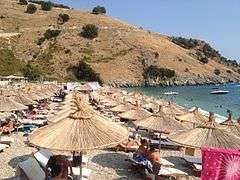
Llamani beach, south of Himara
-
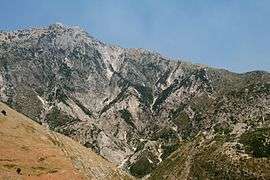
The Ceraunian mountains (Llogara) up close
-

The village of Vuno
-
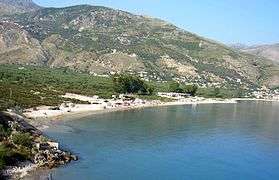
The village of Qeparo
-

The village of Palase
See also
- Autonomous Republic of Northern Epirus
- Ceraunian Mountains
- Chaonians
- Epirus
- Greeks in Albania
- Himariote Greek dialect
- Himara (town)
- List of cities in ancient Epirus
- Northern Epirus
- Tourism in Albania
- Qafa e Vishës bus tragedy
References
- ↑ Anthropological journal on European cultures, v. 3-4, European Centre for Traditional and Regional Cultures, 1994, p. 84
- ↑ UPCYCLING – Albanische Riviera
- ↑ Europa Publications (2003). Central and South-Eastern Europe 2004. 5. Psychology Press. pp. 78–. ISBN 978-1-85743-186-5.
- 1 2 Hammond, 1993: p. 405: "It is one of the several Greek-speaking villages in which the centre is Himare... Liaps"
- ↑ Economist Intelligence Unit (2001). Country Report: Albania. Great Britain: Economist Intelligence Unit. p. 14.
a Greek-speaking district
- ↑ "Albania: The state of a nation" (PDF). ICG Balkans Report N°111. p. 15. Retrieved 2010-09-02.
The coastal Himara region of Southern Albania has always had a predominantly ethnic Greek population.
- 1 2 3 4 5 Tourist Guide of Himarë. Bashkia e Himares. In the intro, written by Vasilis Bolanos, the then-mayor.
- ↑ Masters, Tom (2007). Eastern Europe. Lonely Planet. pp. 65–66. ISBN 978-1-74104-476-8.; Garwood, Duncan (2009). Mediterranean Europe. Lonely Planet. p. 63. ISBN 978-1-74104-856-8.
- ↑ Hammond, NGL (1994). Philip of Macedon. London, UK: Duckworth. "Epirus was a land of milk and animal products...The social unit was a small tribe, consisting of several nomadic or semi-nomadic groups, and these tribes, of which more than seventy names are known, coalesced into large tribal coalitions, three in number: Thesprotians, Molossians and Chaonians...We know from the discovery of inscriptions that these tribes were speaking the Greek language (in a West-Greek dialect)"
- ↑ Hecataeus of Miletus, Fr.103
- ↑ Plutarch, Pyrrhus at The Internet Classics Archive
- ↑ Chimaira, Henry George Liddell, Robert Scott, A Greek-English Lexicon, at Perseus
- ↑ An Inventory of Archaic and Classical Poleis: An Investigation Conducted by The Copenhagen Polis Centre for the Danish National Research Foundation by Mogens Herman Hansen, 2005, p. 340
- ↑ Cheimarros, Henry George Liddell, Robert Scott, A Greek-English Lexicon, at Perseus
- ↑ Badlands, borderlands: a history of Northern Epirus/Southern Albania by Tom Winnifrith,2002,ISBN 0715632019, p. 80
- 1 2 Epirus Vetus: The Archaeology of a Late Antique Province (Duckworth Archaeology) by William Bowden,2003,ISBN 0-7156-3116-0,2003, p. 14
- ↑ Fine 1994, pp. 185–186.
- ↑ Fine 1994, pp. 383, 390.
- ↑ Sakellariou, 1997, p. 244: "In the summer of 1473 the chieftain John Vlasis and a small band of men, using Corfu as a base... while the inhabitants of Cheimara liberated many of the Greek villages."
- ↑ Lucia Gualdo Rosa; Isabella Nuovo; Domenico Defilippis (1982). Gli umanisti e la guerra otrantina: testi dei secoli XV e XVI. EDIZIONI DEDALO. p. 97. ISBN 978-88-220-6005-1.
- ↑ Pappas, 1991: p. 35: "In 1537 the Ottomans mounted an expedition... the maritime privileges of Cheimarra."
- ↑ Pappas, 1991: p. 36: "Even the special privileges which they enjoyed..."
- ↑ Hammond, 1993: p. 405
- ↑ Charles A., Frazee (2006). Catholics and Sultans: The Church and the Ottoman Empire 1453-1923. Cambridge University Press. pp. 103–104.
- ↑ Hammond, 1993: p. 405
- 1 2 Gregorič, 2008: p. 67.
- ↑ Sakellariou, 1997, p. 255: "In Cheimara and the villages of its region (Nivitsa, Hagios Basileios, Loukovo, Keparon, Drymades, Vounos, Pikerni), the court consisted exclusively of elders (laymen), but the execution of its decisions was subject to the sanction of the local bishop (episcopal see at Bouthrotos), who was dependent on the metropolis of Ioannina"
- ↑ Etnografia shqiptare. 15. Akademia e Shkencave e RPSH, Instituti i Historisë, Sektori i Etnografisë. 1987. p. 199.
- ↑ Pappas, 1991, p. 69: "In late 1759 and early 1760, three letters arrived in St. Petersburg from Cheimarra. The first described the conditions of the territory and expressed the willingness of its population to rise against the Turks if the Russians came to free Greece"
- ↑ Antonina Zhelyazkova.Urgent Anthropology. Vol. 2. Albanian Prospects. IMIR, Sofia, 2003. p. 90
- ↑ Pappas, 1991: p. 318: "Following the failure of an insurrection in Cheimarra in 1821"
- ↑ Banac, Ackerman, Szporluk, Vucinich, 1981: p.46: "Cheimarriote veterans played a significant role in the Greek War of Independence (1821-1830)"
- ↑ Sakellariou, 1997, p. 288.
- ↑ Reid, James J. (2000). Crisis of the Ottoman Empire: prelude to collapse 1839-1878. Franz Steiner Verlag. ISBN 978-3-515-07687-6.
- ↑ Skoulidas, Ilias (2001). "The Relations Between the Greeks and the Albanians during the 19th Century: Political Aspirations and Visions (1875-1897)". didaktorika.gr. University of Ioannina: 222. doi:10.12681/eadd/12856.
Οι Χειμαριώτες θεωρούνταν διαρκώς ύποπτοι ευρύτερων ανατρεπτικών σχεδίων στην περιοχή, τα οποία θα εκπορεύονταν από την Ελλάδα.
- ↑ Kondis, Basil (1978). Greece and Albania, 1908-1914. Institute for Balkan Studies. p. 93.
- ↑ Badlands, borderlands: a history of Northern Epirus/Southern Albania by Tom Winnifrith,2002,ISBN 0715632019,page 129
- ↑ Sakellariou, 1997, p. 381.
- 1 2 Meta, Beqir (2008). "Ballafaqimi shqiptaro-grek për Himarën (1920-1924) [Greek-Albanian confrontation in Himara (1920-1924)]." Studime Historike. 1-2: 43: “Pas mbarimit të Luftës I Botërore lëvizja atdhetare shqiptare në Himarë u rigjallërua. Një vend të veçantë luajti Spiro Gogo Koleka, i cili ndihmoi për mbledhjen e Kongresit të Lushnjës dhe zbatimin e vendimeve të tij. Ai bashkë me patriotë të tjerë ishte nënshkruesi i mjaft dokumenteve dërguar përfaqësuesve të Fuqive të Mëdha në Konferencën e Paqes, në të cilat kundërshtohej çdo përpjekje për aneksimin e Vlorës dhe Himarës. Në maj të vitit 1920 Spiro G. Koleka u caktua anëtar i qeverisë kombëtare. Ai më vonë u bë njëri nga organizatorët e Luftës së Vlorës kundër italianëve, në të cilën morën pjesë edhe himarjotë të tjerë.” “[After the end of World War One, the Albanian patriotic movement in Himarë was revived. A special place Spiro Gogo Koleka played, who assisted at the gathering of the Congress of Lushnja and implementation of its decisions. He and other patriots were signatory to many documents sent to the representatives of the Great Powers during the Peace Conference, that opposed any attempt to annex Vlora and Himarë. In May 1920 Spiro G. Koleka was appointed member of the national government. He later became one of the organizers of the Vlora War against the Italians, where other Himariots participated.]”
- 1 2 Basil Kondis (1994). The Greek minority in Albania: a documentary record (1921-1993). Institute for Balkan Studies. ISBN 978-960-7387-02-8.
THE PROTOCOL OF HIMARRA, 1921 We, Spiros Kolekas, Deputy of Valone, General Representative of the Albanian Government for the settlement of the question of the Himarra district, i.e. the villages of Drymades, Vouno, Himarra, Piliouri, Koundessi and Kyparou, which have sent their representatives, Mr G. Bolanos, M. Karas, D. Lekkas and Mr A. Simonides as their Secretary, have agreed upon the following: a) Privileges: The Albanian ...
- ↑ Gregorič, 2008: p. 124.
- ↑ Gregorič, 2008: p. 156.
- ↑ Law nr. 115/2014
- ↑ Gregorič, 2008: p. 44.
- ↑ ,Urgent anthropology Vol. 3. Problems of Multiethnicity in the Western Balkans. International Center for Minority Studies and Intercultural Relations. Sofia 2004. Page 39
- ↑ The politics of national minority participation in post-communist Europe, Jonathan Stein, EastWest Institute, p. 187 "...who came from the predominantly ethnic Greek town of Himara."
- 1 2 Kallivretakis, Leonidas (1995). "Η ελληνική κοινότητα της Αλβανίας υπό το πρίσμα της ιστορικής γεωγραφίας και δημογραφίας [The Greek Community of Albania in terms of historical geography and demography." In Nikolakopoulos, Ilias, Kouloubis Theodoros A. & Thanos M. Veremis (eds). Ο Ελληνισμός της Αλβανίας [The Greeks of Albania]. University of Athens. p. 51. "Ε Έλληνες, ΑΧ Αλβανοί Ορθόδοξοι Χριστιανοί, AM Αλβανοί Μουσουλμάνοι"; p.53. " XIMARA: XIMAPA: 1. FSHAT & SHEN MEHILL ΧΩΡΙΟ & ΑΓΙΟΣ ΜΙΧΑΛΗΣ 1595 E, 2. SPILE ΣΙΠΛΙΑ 3629 E + AX + AM (1000); VUNOS ΒΟΥΝΟΣ 555 ΑΧ; ILIASI ΙΛΙΑΣ 124 ΑΧ; QEPARO POSTHME ΚΗΠΑΡΟ ΚΑΤΩ 854 ΑΧ; QEPARO SIPERME ΚΗΠΑΡΟ ΑΝΩ 461 E; KUDHES ΚΟΥΔΕΣΙ 748 ΑΧ; PILUR ΠΗΛΙΟΥΡΙ 532 ΑΧ; DHERMI ΔΡΥΜΑΔΕΣ, KONDRAPE DHERMI ΚΟΝΤΡΑΠΕ ΔΡΥΜΑΔΩΝ 1550 Ε; PALASA ΠΑΛΙΑΣΣΑ 356 Ε"
- ↑ "Final census findings lead to concerns over accuracy". Tirana Times. Retrieved 26 May 2014.
- ↑ Likmeta, Besar. "Albania Moves Ahead With Disputed Census". Balkaninsight. Retrieved 26 May 2014.
- ↑ "Three Albanian journalists awarded with "World at 7 Billion Prize"". United Nations (Albania). Retrieved 26 May 2014.
...the controversial CENSUS data
- ↑ "International Religious Freedom Report for 2014: Albania" (PDF). http://www.state.gov/. United States, Department of State. p. 5. Retrieved 20 October 2015.
Ethnic Greek minority groups had encouraged their members to boycott the census, affecting measurements of the Greek ethnic minority and membership in the Greek Orthodox Church.
External link in|website=(help) - ↑ "Official 2011 census results per municipality".
- ↑ Kallivretakis, Leonidas (1995). "Η ελληνική κοινότητα της Αλβανίας υπό το πρίσμα της ιστορικής γεωγραφίας και δημογραφίας [The Greek Community of Albania in terms of historical geography and demography." In Nikolakopoulos, Ilias, Kouloubis Theodoros A. & Thanos M. Veremis (eds). Ο Ελληνισμός της Αλβανίας [The Greeks of Albania]. University of Athens. p. 32. α) Γραικούς Χριστιανούς, που τους τοποθετεί σε ολα τα δυτικά χωριά της Δρόπολης ως την Δερβιτζάνη (εκτός από δύο), σε όλα τα ανατολικά χωριά της ίδιας κοιλάδας (εκτός από τρία), σε επτά μεγάλα και αρκετά μικρά χωριά του Δελβίνoυ και σε τρία χωριά της Χιμάρας. β) Αλβανούς Χριστιανούς, στα βόρεια και βορειοανατολικά χωριά της Δρόπολης (περιοχές Λιτζουριάς και Ρίζας), σε ορισμένα χωριά του Δέλβινου, της Χιμάρας, της Πρεμετής και της Κολόνιας καθώς και 20 περίπου χωριά της Κορυτσάς. [a) Greek Christians, placing them in all western villages from Dropull as the Dervitzani (except two), in all the eastern villages of the same valley (except three) in seven large and several small villages Delvinë and also three villages of Himarë. b) Albanian Christians in the north and northeast villages from Dropull (the areas Lunxhëri and Rrëzë), in some villages of Delvinë, Himarë, Përmet and Kolonjë with approximately 20 villages in Korçë.]
- ↑ Banac, Ackerman, Szporluk, Vucinich, 1981: p. 45: “Since, Himara has been part of the disputed border region of Greek and Albania in this century, the question of nationality of the Cheimarriotes has promted much discussion... Leaving conflicting linguistic evidence aside and using the modern criteria of nationality, one cannot label the Cheimarriotes as either Greeks or Albanians. In a narrow sense their alegiances were to their respective clans and areas, and in a broader sense to their religious and cultural heritage. This latter allegiance to Orthodox Christianity would seem to indicate closer ties to their Greek coreligionists than to the Muslim Albanians.”
- ↑ http://www.setimes.com/cocoon/setimes/xhtml/en_GB/features/setimes/newsbriefs/2007/01/22/nb-01
- ↑ Nationalist rhetoric during the campaign, both at the local and national level, had heightened tension in the town over a possible victory by the local ethnic Greek Human Rights Union Party.
- ↑ "Ήττα του υποψήφιου της "Ομόνοιας" στη Χειμάρρα". tovima.gr. Retrieved 9 May 2011.
- ↑ "Municipal Council results in Himarë". Central Commission of Elections of Albania. May 2011. Retrieved 9 May 2011.
- ↑ Election results for the region of Himara in 2013, 2013.
- ↑ Frank Kressing, Karl Kaser. Albania--a country in transition: aspects of changing identities in a South-East European country. Nomos, 2002. p. 129
- 1 2 3 Frazee, Charles A. (2006-06-30). Catholics and Sultans: The Church and the Ottoman Empire 1453-1923. Cambridge University Press. p. 104. ISBN 978-0-521-02700-7. Retrieved 26 December 2010.
- ↑ Murzaku, Ines Angeli (2009). Returning Home to Rome - The Basilian Monks of Grottaferrata in Albania. Analekta Kryptoferris. ISBN 978-88-89345-04-7.
- 1 2 3 4 Erebara, Gjergj. "Albanian Church Demolition Angers Greece". BalkanInsight. Retrieved 26 October 2015. "Albanian police have demolished a contested church dedicated to St Athanas in the southern village of Dhermi, angering the Orthodox Church and neighbouring Greece, which supports the Church's mission. The Orthodox Church called it a vandalistic act of desecration and a violation of church property.... Police used heavy machinery to reduce to rubble the roof built in 1994 to cover the foundations of a much older church destroyed during the communist era.The renovated church was declared an “illegal construction” by the local authorities in Himara municipality two weeks ago, pitting Albanian nationalists against the Greek-supported Orthodox Church.... Speaking about the church, Prime Minister Rama said on Monday that “the old church in Dhermi will be regenerated in the name of national heritage [over] the 'parking lot' that is illegal, which they call a church.”"
- ↑ "Press Release 26.08.2015-The Orthodox church of St. Athanasius was destroyed, Dhermi (Drymades), Himara.". orthodoxalbania.org. Orthodox Autocephalous Church of Albania. Retrieved 26 October 2015.
- ↑ Nikolli, Fatmira. "Albanian Jorgo Goro: Kisha e Shën Thanasit do të rindërtohet, varri i Katalanos është pjesë e projektit [George Goro: St. Athanasius' Church will be rebuilt, Katalano's grave is part of the project.". BalkanWeb. Retrieved 4 November 2015. "Po, do ta kërkojmë varrin e Nilo Katalanos. Do të vazhdojë gërmimi nga arkeologët për nxjerrjen e themeleve dhe të gjitha detajeve dhe më pas do të behet projekti në bashkepunim me Monumentet e Kulturës”. Kështu është shprehur dije për “Gazeta Shqiptare”, kryetari i Bashkisë së Himarës, Jorgo Goro. I pyetur për kohën e shembjes, ai bën me dije se ishte lajmëruar prifti i fshatit për prishjen dhe se kishte kohë deri në 10 për të hequr sendet nga objekti… Për mua është nje reagim i nxituar, se nuk ka prishje të një objekti kulti, por një ndërtim pa leje mbi rrënojat e një kishe mbi 500-vjeçare me histori dhe rëndësi të veçantë për zonën dhe Shqipërinë, gjë që e dinë edhe pjesa më e madhe e banorëve të Dhermiut. Objektin në fjale duam ta rindërtojmë, duke i dhënë vlerat e duhura historike dhe kulturore zonës. Vlerësim të veçantë e nderim i historisë së të parëve tanë si pionierë të Rilindjes. [Yes, we will search for Nilo Katalano's grave. We will continue with excavations by archaeologists and digging until the foundations with all the details which will then become a project in collaboration with the Cultural Monuments sector. This was expressed yesterday for “Gazeta Shqiptare”, by the mayor of Himarë, George Goro. Asked about the time of the demolition, he suggests that the village priest was notified a day prior regarding the demolition and had the time until 10 to remove items from the building… For me it is a rash reaction, because there is no demolition of an object of worship, but an illegal construction on the ruins of a church with 500 years of history and of particular importance to the area and Albania, something which most of the residents of Dhërmi know. The object in question, we want to rebuild by giving proper values of the historical and cultural area. Special appreciation and honor to the history of our ancestors as pioneers of the Renaissance.]"
- ↑ "European Commission criticizes Albania for the incident with the Church of Dhermi". Independent Balkan News Agency. Retrieved 4 November 2015.
The European Commission has issued a strong reaction in relation to the demolition of the orthodox church in the south of Albania and calls on Albanian authorities to respect religious freedoms for the citizens of the country, while it includes the incident in the upcoming Progress Report.
- ↑ Gregorič, 2008: p. 43: most of the people who claim to originate from Himarë/Himara area have declared themselves as horiani (pl.), meaning locals.
- ↑ Gregorič, 2008: p. 63.
- ↑ Gregorič, 2008: p. 68
- 1 2 3 4 5 George Gilson (27 September 2010). "Bad blood in Himara". Athens News. Retrieved 4 November 2010.
- 1 2 3 4 "Tensions resurface in Albanian-Greek relations". Balkan Chronicle. 13 September 2010. Retrieved 4 November 2010.
- ↑ "Amnesty International Report 1995 - Albania". Amnesty International. 27 September 2010. Retrieved 30 December 2010.
- ↑ Bönisch-Brednich, edited by Brigitte; Trundle, Catherine (2010). Local lives : migration and the politics of place (null ed.). Farnham, Surrey, England: Ashgate Pub. p. 26. ISBN 978-1-4094-0103-2.
- ↑
- ↑ "Macedonians and Greeks Join Forces against Albanian Census". balkanchronicle. Retrieved 24 September 2011.
- ↑ "International Religious Freedom Report for 2014: Albania" (PDF). http://www.state.gov/. United States, Department of State. p. 5. Retrieved 20 October 2015.
Ethnic Greek minority groups had encouraged their members to boycott the census, affecting measurements of the Greek ethnic minority and membership in the Greek Orthodox Church.
External link in|website=(help) - ↑ "Αλβανία: Κατεδάφισαν εκκλησία στη Χειμάρρα – Αθήνα: Eίναι τζιχαντιστές". skai.
- ↑ Banac, Ackerman, Szporluk, Vucinich, 1981: p. 46
- ↑ Banac, Ackerman, Szporluk, Vucinich, 1981: p. 46
- ↑ Marko, Petro. Intervistë me vetveten (Retë dhe gurët) (memories). OMSCA, 2000. 99927-40-33-7
Sources
- Banac, Ivo; Ackerman, John G.; Szporluk, Roman; Vucinich, Wayne S. (1981). Nation and ideology: essays in honor of Wayne S. Vucinich. East European Monographs. ISBN 978-0-914710-89-9.
- Fine, John V. A. (1994). The Late Medieval Balkans: A Critical Survey from the Late Twelfth Century to the Ottoman Conquest. University of Michigan Press. ISBN 0-472-08260-4.
- Gregorič, Nataša. "Contested Spaces and Negotiated Identities in Dhërmi/Drimades of Himarë/Himara area, Southern Albania" (PDF). University of Nova Gorica. Retrieved 2010-08-15.
- Hammond, Nicholas Geoffrey Lemprière (1993). Collected Studies: Alexander and his successors in Macedonia. A.M. Hakkert. ISBN 978-90-256-1051-7.
- Kallivretakis, Leonidas (1995). "Η ελληνική κοινότητα της Αλβανίας υπό το πρίσμα της ιστορικής γεωγραφίας και δημογραφίας [The Greek Community of Albania in terms of historical geography and demography]". In Veremis, Thanos. Ο Ελληνισμός της Αλβανίας [The Greeks of Albania]. University of Athens. pp. 25–58. ISBN 9600800545.
- Pappas, Nicholas Charles (1991). Greeks in Russian military service in the late eighteenth and early nineteenth centuries. Institute for Balkan Studies.
- Sakellariou, M. V. (1997). Epirus, 4000 Years of Greek History and Civilization. Athēna: Ekdotike Athenon. ISBN 9602133716.
External links
| Wikimedia Commons has media related to Himara. |
- Official Himara Travel Guide
- Region of Himarë. Official municipality website
- Research Foundation
- Greeks in Albania
- Himara's Directory
- Merceneries from Himara
